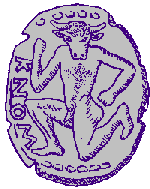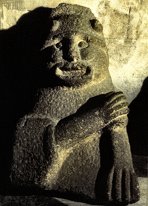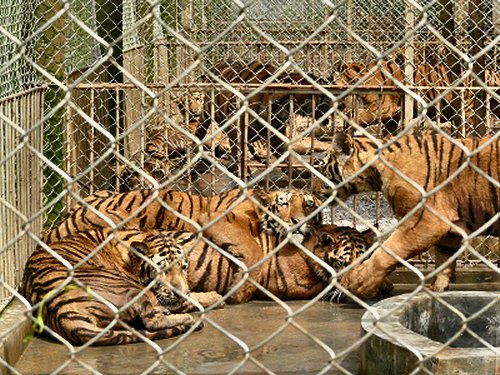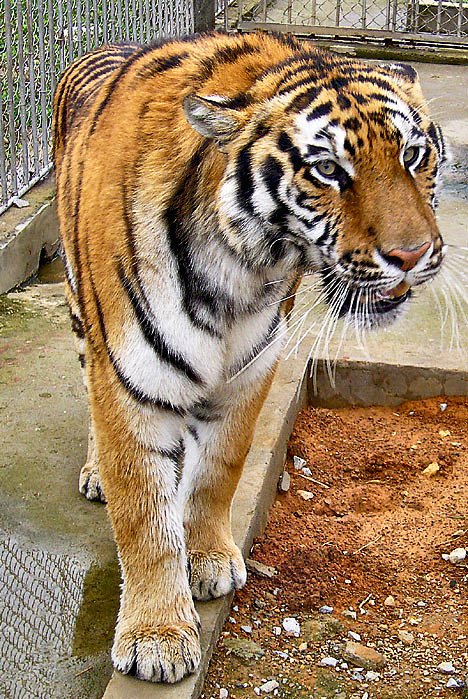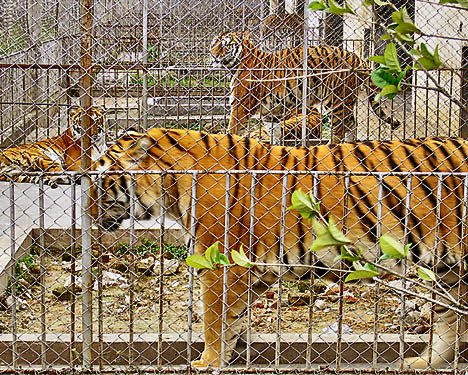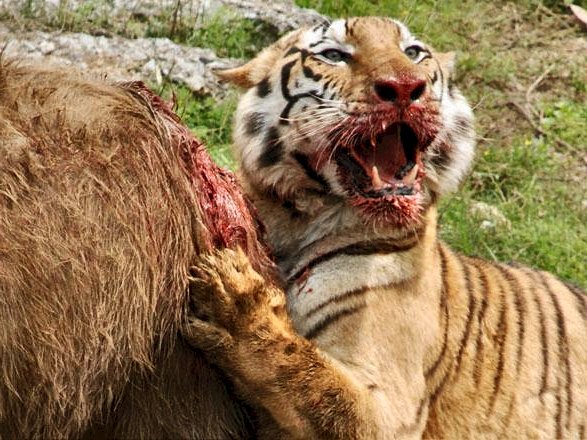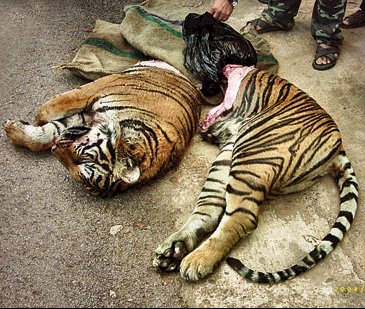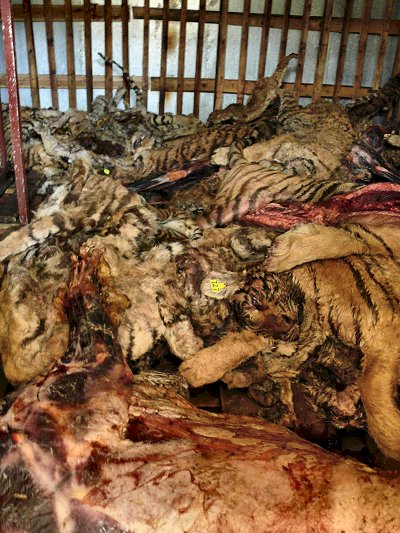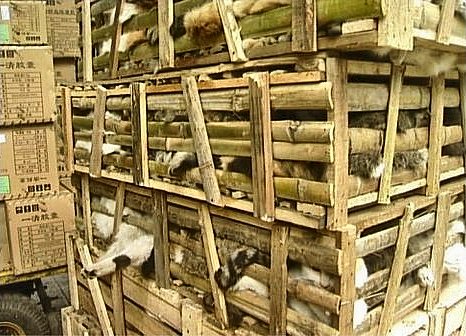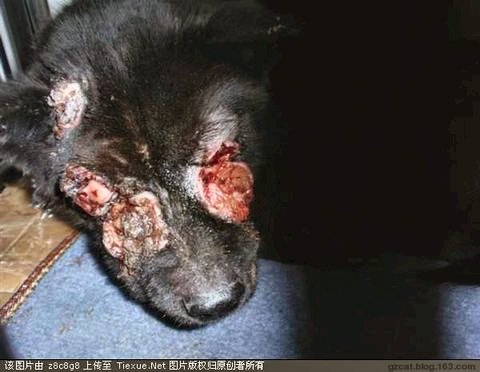|
|
|
this site only |
XIONGSEN
|
300 African
lions just
one of many "farms" Tiger
wine £200
a litre. Very,
very cheap.
adapted from a report from FACTORY-FARM
TIGERS by Danny Penman, 12th March 2007 Cruel almost beyond belief, a Chinese farm breeds hundreds of tigers in rows of battery cages ... so they can be killed and turned into wine. King, the Siberian tiger, stares at me through the bars of his cage. His two beautiful, graceful companions pace back and forth across their tiny compound. They look crushingly bored. The most exciting thing they can do is paw mournfully at the dirty pools of rainwater on the floor of their cage. Oh,
what shoulder, & what art Although the Xiongsen tiger park, near Guilin in Hunan Province, south-east China, appears to be a depressingly typical Third World zoo, with a theme park restaurant and open areas where tigers roam, it actually hides a far more sinister secret: it's a factory farm breeding tigers to be eaten - and to be made into wine. In row upon row of sheds, hundreds of tigers are incarcerated in row upon row of cages which they never leave - until they are slaughtered. Visitors to the park can dine on strips of stir-fried tiger with ginger and Chinese vegetables. Also on the menu are tiger soup and a spicy red curry made with tenderised strips of the big cat. Visitors can wash it all down with a glass or two of wine made from Siberian tiger bones. A waitress at the farm's restaurant tells me proudly: "The tiger meat is produced here. It's our business. When Government officials come here, we kill a tiger for them so they have fresh meat. Other visitors are given meat from tigers killed in fights. We now have 140 tigers in the freezer. "We
also sell lion meat, bear's paw, crocodile and snake. The bear's
paw has to be ordered in advance as it takes a long time to cook."
Tigers and other endangered species are being reared on an industrial scale through-out China, despite international treaties forbidding this. The Mail discovered three factory farms breeding tigers in China. The Guilin farm alone has 1,300 tigers, including the incredibly rare and elusive Siberian sub-species. It rears and slaughters Bengal, South China and White tigers. More than 300 African lions and 400 Asiatic black bears are also reared here for food and 'Traditional Chinese Medicines'. The Chinese authorities claim that farms like the one at Guilin are a vital part of the country's conservation efforts, and that they will one day release these endangered creatures back into the wild. But my visit to the Xiongsen Bear and Tiger Mountain Village revealed that their real intention could not be more different. For the fact is that these poor, deprived animals could never survive in the wild. Having spent their lives in tiny, battery-style units, they cannot hunt and would be dead within days of being released. Each shed at the tiger farm - and I saw at least 100 - houses between three and five tigers in a space no larger than a typical family living room. In relative terms, they have about as much space as a battery hen. [Hens - in their billions - suffer just as much, of course, but are not nearing extinction.]
The animals have all been bred on the farm. The cubs are taken from their mothers at three months and put in a kindergarten. I saw around 30 tiger cubs in this 'crèche', where they stay until they are old enough to be transferred to the battery units. Many of the youngsters kept leaping at the fencing. The younger ones simply wanted to play like kittens. The older cubs were already showing signs of stress. Tigers are naturally solitary creatures that roam over dozens of square miles, so it's hardly surprising that life in the cages drives them insane. I saw numerous examples of stress-related repetitive behaviour. The mature animals paced back and forth across their cages for hours on end - three steps forward, three steps back. Some hurled themselves at the bars of their prison cells, while others simply stared into space. Over-crowding drives the creatures to attack each other, often resulting in death. Officially it is only the tigers killed in such fights that can be eaten or turned into wine. But it is clear that many of them are released from their unimaginable misery by a bullet in the brain. They are not the only animals killed. For entertainment, visitors to the animal park can watch the Live Kill, a sick spectacle in which animals are 'hunted' and torn to pieces by tigers while onlookers cheer. I watched in horror as a heifer was stalked and caught by a tiger. Its screams filled the air as it struggled.
A wild tiger would dispatch its prey within moments, but these tigers' natural killing skills have been stunted by years of captivity. The tiger tried to kill - tearing, biting at the cow's body in a pathetic-looking frenzy - but it simply didn't know how. Eventually, the keepers stepped in and put the cow out of its misery. Virtually all the tigers from the Guilin farm end up at a winery 100 miles to the north, their carcasses dumped in huge vats of rice wine and left to rot for up to nine years. The Chinese believe that the tiger's strength passes into the wine as its body decomposes. They also believe that it is a powerful medicine that wards off arthritis, strengthens bones and acts as a general tonic. Smelling like a mixture of methylated spirits, antiseptic and old meat, it is difficult to believe that anyone would willingly drink it, and yet people pay up to £100 a pint for it. The Guilin farm also has its own small winery and acts as a distribution centre across China. The distribution manager showed me around with a Chinese tourist. A small dingy office acts as the nerve centre of the warehouse. On the wall were charts showing that day's deliveries of tiger wine across China. Six crates were sent to Wuhan and another to Tianjing. Six crates of 'powdered bear' were sent to Shanghai. Numerous other cities and countless deliveries were also listed. We were led into the warehouse, where I was hit with the disgusting and potent aroma of tiger wine. I was led past countless crates containing the foul-smelling brew. In the corner of the warehouse was a huge brown earthenware vat. It must have held at least 50 gallons, and its contents were probably worth around £12,000. "We have three ages of wine," said the manager. "Three, six or nine-years old. It helps with arthritis and strengthens old people's bones." She slid aside the lid of the earthenware vat to reveal a reddish-brown liquid with an overpowering smell of meths. A piece of string was pulled out of the vat. Attached to the end was a tiger's rib cage. Small slivers of dark red flesh could still be seen clinging to the bone, even though it had probably been in the vat for at least three years. The manager then filled up an old plastic water bottle with a pint of wine and handed it to my fellow tourist. He paid £30 for it. Whatever westerners think of tiger wine, the Chinese regard it as a potent drink with almost magical qualities. In the past, a Chinese doctor may have prescribed small quantities of wine for a short period of time. But in recent years, big companies have moved into the market and industrialised all parts of the industry. Now the wine is becoming an essential drink for China's corrupt bureaucrats and the nation's nouveaux-riches. Conservationists say tiger farming is not only barbaric, it could lead to the animal's extinction in the wild. "It is stimulating demand for meat and wine, and this will inevitably lead to more poaching," says Grace Gabriel, of the International Fund for Animal Welfare. "It costs £5,000 to raise a tiger from a cub to maturity in one of these farms, while it costs no more than £20 in India to poach one. On the market, a dead tiger can fetch £20,000. "With such a huge margin, it is inevitable that more people will poach wild tigers if demand increases," she adds. "There are only a few thousand tigers left in the wild, and the last thing they need is increased demand for their body parts."
What dread hand? & what dread feet?
There are only about 450 Siberian tigers left in Russia's Far East. The remaining 3-4,000 are sparsely scattered across India, Nepal and South-East Asia. The trouble is that, as tigers become rarer in the wild, their 'street value' increases, which in turn encourages even more poaching. Tigers have already become extinct in India's most famous reserve at Sariska. Numbers have plunged in several other reserves, too. Most of these tigers will have been sold to traders in China. The Chinese authorities do virtually nothing to clamp down on this illegal trade, and many corrupt bureaucrats and police earn substantial sums from it. And demand is continuing to increase as ever more bizarre uses for tigers are promoted. Tiger whiskers are used to 'cure' laziness and protect against bullets. Their brains, when mixed with oil and rubbed on the skin, are promoted as a cure for acne. Penises are used as aphrodisiacs, while hearts apparently impart courage, cunning and strength. Although it is illegal to trade internationally in such tiger products as wine, the Chinese are lobbying hard to get the law relaxed. This June 2007, the Chinese Government is expected to press the Convention on the International Trade in Endangered Species (CITES) to allow the trade in 'medicines' such as wine produced from farmed tigers. If agreed, it will lead to a massive increase in tiger farming and tens of thousands of these noble beasts will spend their lives in battery cages. If the Chinese get their way, then it will almost certainly drive the tigers over the cliff into extinction. It is almost too late to save this magnificent creature - but not quite.
What the hammer? what the chain? photos © Belinda Wright WPSI-ITC |
Meanwhile, elsewhere in southern China:
crated cats awaiting transport for slaughter,
and a suffering dog.
read RILKE'S poem about the Leopard in the Paris zoo =>
![]()

